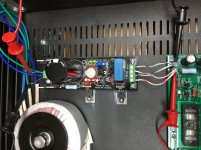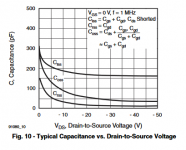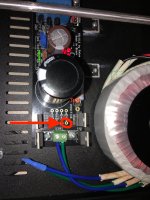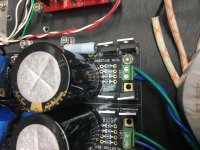Those sinks are quite minimal by the way.
Yes, I put them on for testing. They will sink to chassis floor in the completed build.
The PS seems to be quite happy chugging along at 24Vdc at the output. My input voltage is 23Vac with the load on it, this would give me ~32Vdc at the regulator, correct? with the output voltage trimmed to 24Vdc this would give me 8V to spare in the regulator, correct? Q301 stays quite cool at 31°C, Q306 cycles between 32°C and 36°C over a period of a minute or so. Last night Q306 cycled between 39°C and 41°C. Is this normal? I noticed line voltage is up a little bit today and also that it takes about 5 minutes for the output to creep up to 24Vdc. Thank you very much for all you do Salas!

PS I'm not sure of my selections for capacitors, I just put in what I had laying around. Any suggestion? Also, I have 4.6Vdc between pins 1 and 3 on Q301.

PS I'm not sure of my selections for capacitors, I just put in what I had laying around. Any suggestion? Also, I have 4.6Vdc between pins 1 and 3 on Q301.
Last edited:
All descriptions seem normal. You should also deduct 1.4V total rectification diodes drop from expected raw DC calculations. Line voltage level can add or subtract little heat from Q301. While Q306's heat is affected by CCS setting minus load consumption in mA times Vout Voltage (producing Watt). Both are affected by ambient temperature of course. Your capacitors are very good types. What is the voltage drop across the legs of the 10R CCS resistor?
What is the voltage drop across the legs of the 10R CCS resistor?
2.6VDC
BTW this isn't going to be the actual transformer I use in this build. I can order something with more Voltage if advantageous.
Last edited:
2.6V/10R = 260mA CCS. Up to 10-15V Vin-Vout (VDS) seems still logical for Q301's dissipation given your measured temp with 7V. More voltage across promotes less parasitic capacitance inside Q301. In any case never use less than 5V. It becomes quite slower (capacitive) under 5V VDS.
Attachments
For 27V rail on common between channels PSU you may set 130mA CCS. Resulting to 2.7W Q106 dissipation for 30mA load consumption and 100mA shunt current. Very manageable.
On how to configure the reg best for the target CCS current and the voltage range of interest, both the XLS calculator and the PDF manual from post#1 have all the details.
On how to configure the reg best for the target CCS current and the voltage range of interest, both the XLS calculator and the PDF manual from post#1 have all the details.
- Home
- Amplifiers
- Power Supplies
- SSLV1.1 builds & fairy tales


